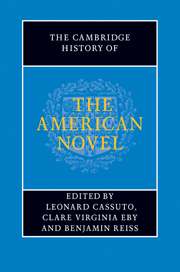Book contents
- Frontmatter
- General Introduction
- PART ONE INVENTING THE AMERICAN NOVEL
- Introduction: inventing the American novel
- 1 Transatlantic currents and the invention of the American novel
- 2 Susanna Rowson, Hannah Webster Foster, and the seduction novel in the early US
- 3 Charles Brockden Brown and the novels of the early republic
- 4 The novel in the antebellum book market
- 5 American land, American landscape, American novels
- 6 Cooper and the idea of the Indian
- 7 The nineteenth-century historical novel
- 8 Hawthorne and the aesthetics of American romance
- 9 Melville and the novel of the sea
- 10 Religion and the nineteenth-century American novel
- 11 Manhood and the early American novel
- 12 Sentimentalism
- 13 Supernatural novels
- 14 Imagining the South
- 15 Stowe, race, and the antebellum American novel
- 16 The early African American novel
- PART TWO REALISM, PROTEST, ACCOMMODATION
- PART THREE MODERNISM AND BEYOND
- PART FOUR CONTEMPORARY FORMATIONS
- A selected bibliography
- Index
9 - Melville and the novel of the sea
from PART ONE - INVENTING THE AMERICAN NOVEL
Published online by Cambridge University Press: 28 July 2011
- Frontmatter
- General Introduction
- PART ONE INVENTING THE AMERICAN NOVEL
- Introduction: inventing the American novel
- 1 Transatlantic currents and the invention of the American novel
- 2 Susanna Rowson, Hannah Webster Foster, and the seduction novel in the early US
- 3 Charles Brockden Brown and the novels of the early republic
- 4 The novel in the antebellum book market
- 5 American land, American landscape, American novels
- 6 Cooper and the idea of the Indian
- 7 The nineteenth-century historical novel
- 8 Hawthorne and the aesthetics of American romance
- 9 Melville and the novel of the sea
- 10 Religion and the nineteenth-century American novel
- 11 Manhood and the early American novel
- 12 Sentimentalism
- 13 Supernatural novels
- 14 Imagining the South
- 15 Stowe, race, and the antebellum American novel
- 16 The early African American novel
- PART TWO REALISM, PROTEST, ACCOMMODATION
- PART THREE MODERNISM AND BEYOND
- PART FOUR CONTEMPORARY FORMATIONS
- A selected bibliography
- Index
Summary
By the time Herman Melville began work on his third novel, Mardi (1849), he had already enjoyed popular and critical success with his first two sea narratives, Typee (1846) and Omoo (1847). The earlier Polynesian writing had reflected to some degree his experiences as a sailor and beachcomber in the South Pacific, where Melville had spent time after deserting a whaleship. In fact, Typee and Omoo were presented to the reading public as narratives of experience, rather than novels; yet they were held to be fantastic by many reviewers, many of whom shared the judgment of one early commentator: “We cannot escape a slight suspicion … that there is an indefinite amount of romance mingled with the reality of his narrative.” The seemingly opposed generic categories of “romance” and “narrative” used to identify his first two works are explicitly taken up by Melville in the brief note that opens Mardi. Here, Melville refers to the reception of the earlier sea narratives in terms of such formal distinctions: “Not long ago, having published two narratives of voyages in the Pacific, which, in many quarters, were received with incredulity,” he begins, “the thought occurred to me, of indeed writing a romance of Polynesian adventure, and publishing it as such.” His goal in doing so, he writes somewhat wryly, is “to see whether, the fiction might not, possibly, be received for a verity; in some degree the reverse of my previous experience.” Aiming for “the reverse” of his previous experience, Melville would achieve it in ironic and unanticipated fashion: whereas Typee and Omoo were well received bestsellers, Mardi mystified reviewers and frustrated readers.
- Type
- Chapter
- Information
- The Cambridge History of the American Novel , pp. 151 - 166Publisher: Cambridge University PressPrint publication year: 2011

